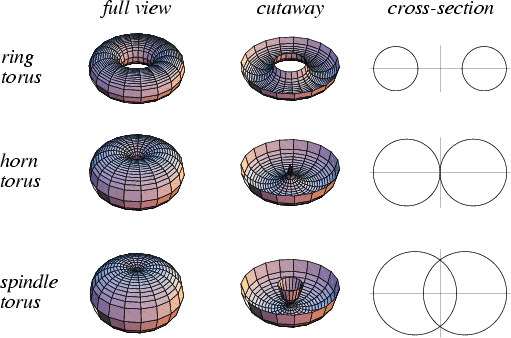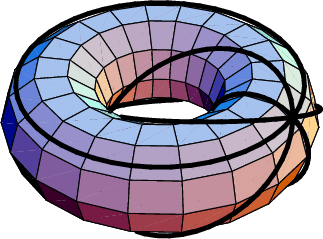|
|
|
A torus is a surface having Genus 1, and therefore possessing a single ``Hole.'' The usual
torus in 3-D space is shaped like a donut, but the concept of the torus is extremely useful in higher dimensional space as
well. One of the more common uses of ![]() -D tori is in Dynamical Systems. A fundamental result
states that the Phase Space trajectories of a Hamiltonian System with
-D tori is in Dynamical Systems. A fundamental result
states that the Phase Space trajectories of a Hamiltonian System with ![]() Degrees of Freedom and possessing
Degrees of Freedom and possessing ![]() Integrals of Motion lie on an
Integrals of Motion lie on an ![]() -D Manifold which is
topologically equivalent to an
-D Manifold which is
topologically equivalent to an ![]() -torus (Tabor 1989).
-torus (Tabor 1989).
The usual 3-D ``ring'' torus is known in older literature as an ``Anchor Ring.'' Let the radius from the center of
the hole to the center of the torus tube be ![]() , and the radius of the tube be
, and the radius of the tube be ![]() . Then the equation in Cartesian
Coordinates is
. Then the equation in Cartesian
Coordinates is
| (1) |
| (2) | |||
| (3) | |||
| (4) |
If no specification is made, ``torus'' is taken to mean Ring Torus. The three Standard Tori are illustrated below, where the first image shows the full torus, the second a cut-away of the bottom half, and the third a Cross-Section of a plane passing through the z-Axis.

The Standard Tori and their inversions are Cyclides. If the coefficient of ![]() in the formula
for
in the formula
for ![]() is changed to
is changed to ![]() , an Elliptic Torus results.
, an Elliptic Torus results.

To compute the metric properties of the ring torus, define the inner and outer radii by
| (5) | |||
| (6) |
| (7) | |||
| (8) |
| (9) | |||
| (10) |
| (11) | |||
| (12) |
The coefficients of the first and second Fundamental Forms of the torus are given by
| (13) | |||
| (14) | |||
| (15) | |||
| (16) | |||
| (17) | |||
| (18) |
| (19) |
| (20) |
| (21) | |||
| (22) |
A torus with a Hole in its surface can be turned inside out to yield an identical torus. A torus can be knotted externally or internally, but not both. These two cases are Ambient Isotopies, but not Regular Isotopies. There are therefore three possible ways of embedding a torus with zero or one Knot.

An arbitrary point ![]() on a torus (not lying in the
on a torus (not lying in the ![]() -plane) can have
four Circles drawn through it. The first circle is in the plane of the torus and the second is
Perpendicular to it. The third and fourth Circles are called Villarceau Circles
(Villarceau 1848, Schmidt 1950, Coxeter 1969, Melnick 1983).
-plane) can have
four Circles drawn through it. The first circle is in the plane of the torus and the second is
Perpendicular to it. The third and fourth Circles are called Villarceau Circles
(Villarceau 1848, Schmidt 1950, Coxeter 1969, Melnick 1983).
To see that two additional Circles exist, consider a coordinate system with origin
at the center of torus, with ![]() pointing up. Specify the position of
pointing up. Specify the position of ![]() by its Angle
by its Angle ![]() measured
around the tube of the torus. Define
measured
around the tube of the torus. Define ![]() for the circle of points farthest away from the center of the torus (i.e.,
the points with
for the circle of points farthest away from the center of the torus (i.e.,
the points with ![]() ), and draw the x-Axis as the intersection of a plane through the
), and draw the x-Axis as the intersection of a plane through the ![]() -axis and
passing through
-axis and
passing through ![]() with the
with the ![]() -plane. Rotate about the y-Axis by an Angle
-plane. Rotate about the y-Axis by an Angle ![]() , where
, where
| (23) |
| (24) | |||
| (25) |
| (26) |
|
|
|
|
|
|
|
|
(27) |
| (28) |
| (29) |
| (30) |
| (31) |
| (32) |
![$\displaystyle \left[\begin{array}{c}c\cos t\\ c\sin t+a\\ 0\end{array}\right]$](t_906.gif) |
(33) | ||
![$\displaystyle \left[\begin{array}{c}c\cos t\\ c\sin t-a\\ 0\end{array}\right].$](t_908.gif) |
(34) |
![$\displaystyle \left[\begin{array}{ccc}\cos\theta & 0 & -\sin\theta\\ 0 & 1 & 0...
...array}\right] \left[\begin{array}{c}c\cos t\\ c\sin t+a\\ 0\end{array}\right]$](t_910.gif) |
|||
![$\displaystyle \left[\begin{array}{c}c\cos\theta\cos t\\ c\sin t+a\\ -c\sin\theta\cos t\end{array}\right]$](t_911.gif) |
(35) | ||
![$\displaystyle \left[\begin{array}{ccc}\cos\theta & 0 & \sin\theta\\ 0 & 1 & 0\...
...array}\right] \left[\begin{array}{c}c\cos t\\ c\sin t-a\\ 0\end{array}\right]$](t_912.gif) |
|||
![$\displaystyle \left[\begin{array}{c}c\cos\theta\cos t\\ c\sin t-a\\ -c\sin\theta\cos t\end{array}\right].$](t_913.gif) |
(36) |
| (37) |
| (38) |
| (39) |
![$\displaystyle \left[\begin{array}{ccc}\cos\psi & \sin\psi & 0\\ -\sin\psi & \c...
...array}{c}c\cos\theta\cos t\\ c\sin t+a\\ -c\sin\theta\cos t\end{array}\right]$](t_919.gif) |
(40) | ||
![$\displaystyle \left[\begin{array}{ccc}\cos\psi & \sin\psi & 0\\ -\sin\psi & \c...
...array}{c}c\cos\theta\cos t\\ c\sin t-a\\ -c\sin\theta\cos t\end{array}\right]$](t_920.gif) |
(41) | ||
![$\displaystyle \left[\begin{array}{c}(c+a\cos\phi)\cos t\\ (c+a\cos\phi)\sin t\\ a\sin\phi\end{array}\right]$](t_922.gif) |
(42) | ||
![$\displaystyle \left[\begin{array}{c}c+a\cos t\\ 0\\ a\sin t\end{array}\right].$](t_924.gif) |
(43) |
See also Apple, Cyclide, Elliptic Torus, Genus (Surface), Horn Torus, Klein Quartic, Lemon, Ring Torus, Spindle Torus, Spiric Section, Standard Tori, Toroid, Torus Coloring, Torus Cutting
References
Beyer, W. H. CRC Standard Mathematical Tables, 28th ed. Boca Raton, FL: CRC Press, pp. 131-132, 1987.
Coxeter, H. S. M. Introduction to Geometry, 2nd ed. New York: Wiley, pp. 132-133, 1969.
Geometry Center. ``The Torus.'' http://www.geom.umn.edu/zoo/toptype/torus/.
Gray, A. ``Tori.'' §11.4 in Modern Differential Geometry of Curves and Surfaces.
Boca Raton, FL: CRC Press, pp. 218-220 and 289-290, 1993.
Melzak, Z. A. Invitation to Geometry. New York: Wiley, pp. 63-72, 1983.
Pinkall, U. ``Cyclides of Dupin.'' §3.3 in
Mathematical Models from the Collections of Universities and Museums (Ed. G. Fischer).
Braunschweig, Germany: Vieweg, pp. 28-30, 1986.
Schmidt, H. Die Inversion und ihre Anwendungen. Munich: Oldenbourg, p. 82, 1950.
Tabor, M. Chaos and Integrability in Nonlinear Dynamics: An Introduction. New York: Wiley, pp. 71-74, 1989.
Villarceau, M. ``Théorème sur le tore.'' Nouv. Ann. Math. 7, 345-347, 1848.
|
|
|
© 1996-9 Eric W. Weisstein